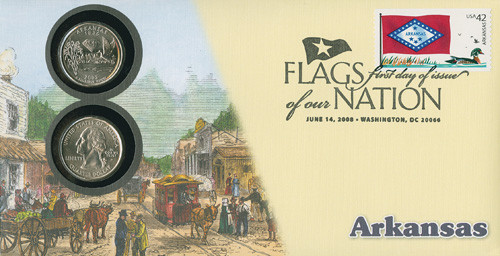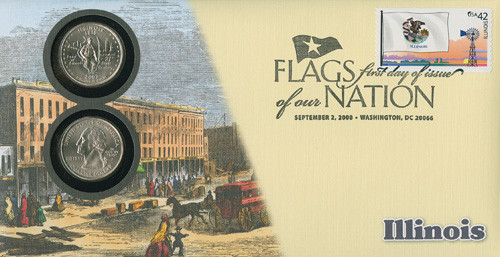
# CNC27 - 2008 42c Flags of Nation, Guam coin
2008 42¢ Flags of Our Nation
This Flags of Our Nation Coin Cover features the Guam stamp from the Flags of Our Nation Series, two uncirculated territory quarters, and a cachet, or picture, that reflects the history of the territory.
A historic 1800s Chamorro village is illustrated on the colorized woodcut cachet of this cover. Guam was settled around 4,000 years ago by the Chamorro, a strong, seafaring people who sailed from Southeast Asia. Controlled by Spain, Japan, and the U.S.A. since the 1500s, the Chamorro have managed to keep much of their culture alive.
Guam’s flag features a tropical scene filled with symbolism. The bowed coconut tree at its center is considered the “Tree of Life.” It shows how the people of Guam have bent like the tree to survive wars, famine, and natural disasters. The mountains in the background represent the people’s commitment to the land. And the Agana River meeting the sea symbolizes their willingness to share their island. A Chamorro Flying Proa sails in Agana Bay. The unique ship can be seen on the Guam quarter as well.
Engineering marvels, Flying Proas were the fastest sailing vessels in the world in the 1500s. Different from other ships, the bows and sterns were identical, so they could change direction without turning. Outriggers kept the boats afloat in rough seas. When Magellan first visited Guam, hundreds of speedy, agile Proas met his ship. But, banned by the Spanish, the Proas disappeared from Guam around 1800. Today, Chamorro are working to revive the lost art of Proa building using old drawings, eyewitness descriptions, and archeological findings, along with their own special ingenuity.
2008 42¢ Flags of Our Nation
This Flags of Our Nation Coin Cover features the Guam stamp from the Flags of Our Nation Series, two uncirculated territory quarters, and a cachet, or picture, that reflects the history of the territory.
A historic 1800s Chamorro village is illustrated on the colorized woodcut cachet of this cover. Guam was settled around 4,000 years ago by the Chamorro, a strong, seafaring people who sailed from Southeast Asia. Controlled by Spain, Japan, and the U.S.A. since the 1500s, the Chamorro have managed to keep much of their culture alive.
Guam’s flag features a tropical scene filled with symbolism. The bowed coconut tree at its center is considered the “Tree of Life.” It shows how the people of Guam have bent like the tree to survive wars, famine, and natural disasters. The mountains in the background represent the people’s commitment to the land. And the Agana River meeting the sea symbolizes their willingness to share their island. A Chamorro Flying Proa sails in Agana Bay. The unique ship can be seen on the Guam quarter as well.
Engineering marvels, Flying Proas were the fastest sailing vessels in the world in the 1500s. Different from other ships, the bows and sterns were identical, so they could change direction without turning. Outriggers kept the boats afloat in rough seas. When Magellan first visited Guam, hundreds of speedy, agile Proas met his ship. But, banned by the Spanish, the Proas disappeared from Guam around 1800. Today, Chamorro are working to revive the lost art of Proa building using old drawings, eyewitness descriptions, and archeological findings, along with their own special ingenuity.











